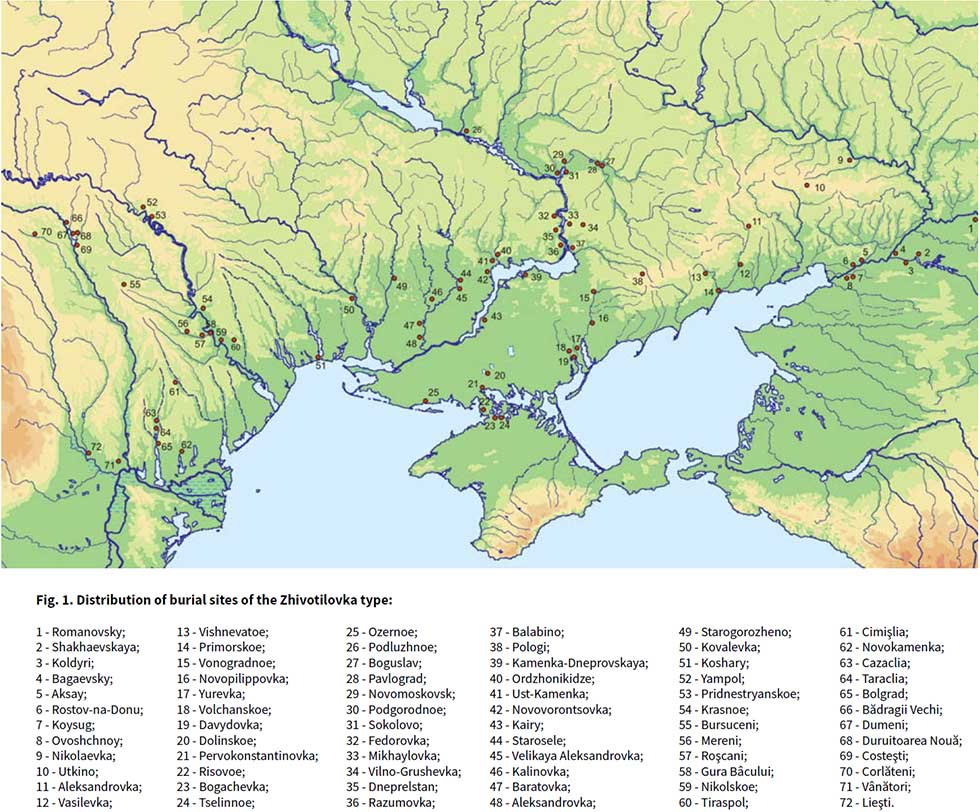The recent update on the Indo-Anatolian homeland in the Middle Volga region and its evolution as the Indo-Tocharian homeland in the Don–Volga area as described in Anthony (2019) has, at last, a strong scientific foundation, as it relies on previous linguistic and archaeological theories, now coupled with ancient phylogeography and genomic ancestry.
There are still some inconsistencies in the interpretation of the so-called “Steppe ancestry”, though, despite the one and a half years that have passed since we first had access to the closest Pontic–Caspian steppe source populations. Even my post “Steppe ancestry” step by step from a year ago is already outdated.
Admixture
The population selection process for models shown below included (1) plausibility of potential influences in the particular geographic and archaeological context; (2) looking for their clusters or particular samples in the PCA; and (3) testing with qpAdm for potential source populations that might have been involved in their development.
The results and graphics posted are therefore intended to simplistically show potential admixture events between populations potentially close to the actual sources of the target samples, whenever such mating networks could be supported by archaeology.
NOTE. This is an informal post and I am not a geneticist, so I am turning this flexibility to my advantage. If any reader is – for some strange reason – looking for a strict hypothesis testing, for the use of a full set of formal stats (as used e.g. in Ning et al. 2019 for Proto-Tocharians), and correctly redacted and peer-reviewed text, this is not the right place to find them.
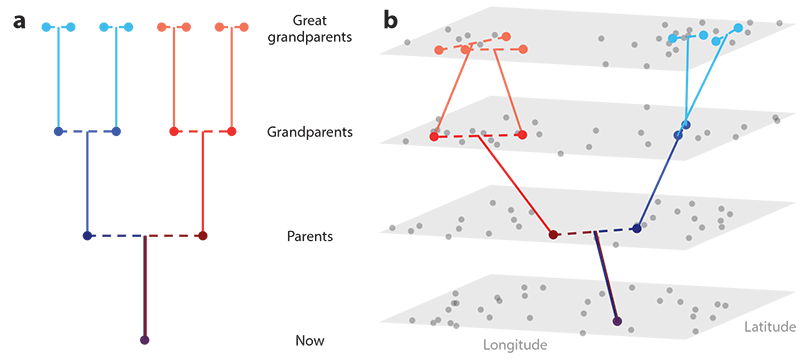
Despite the natural impulse to draw straight mixture trajectories (see e.g. Wang et al. 2019), simply adding or subtracting samples used for a PCA shows how the plot is affected by different variables (see e.g. what happens by including more South Asian samples to the PCA below), hence the need to draw curved arrows – not necessarily representing a sizable drift; at least not in recent prehistoric admixture events for which we have a reasonable chronological transect.
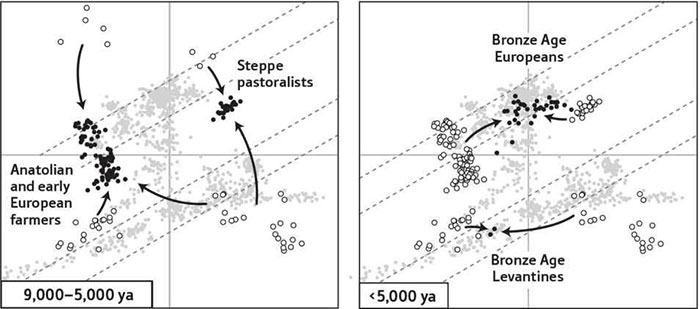
Ethnolinguistic identification is a risky business that brings back memories of an evil use of cultural history and its consequences (at least in Western Europe, where this tradition was discontinued after WWII), but it seems necessary for those of us who want to find some confirmation of proposed dialectal schemes and language contacts.
Eneolithic Steppe vs. Steppe Maykop
First things first: I tested Bronze Age Eurasian peoples for the only two true steppe populations sampled to date, as potential sources of their “Steppe ancestry” – conventionally described as an EHG:CHG admixture, similar to that found in the first sampled Yamnaya individuals. I used the rightpops of Wang et al. (2018), but with a catch: since authors used WHG as a leftpop and Villabruna as a rightpop, and I find that a little inconsequential*, I preferred the strategy in Ning et al. (2019), contrasting as outgroup Eneolithic_Steppe (ca. 4300 BC) vs. Steppe_Maykop (ca. 3500 BC) when testing for WHG as a source population.
*WHG usually includes samples from a ‘western’ cluster (Loschbour and La Braña) and an ‘eastern’ cluster (Villabruna and Koros), see Lipson et al. (2017). Therefore, it doesn’t make much sense to include the same (or a very similar) population as a source AND an outgroup.
NOTE. For all other qpAdm analyses below, where WHG was not used as leftpop, I have used Villabruna as rightpop following Wang et al. (2019).
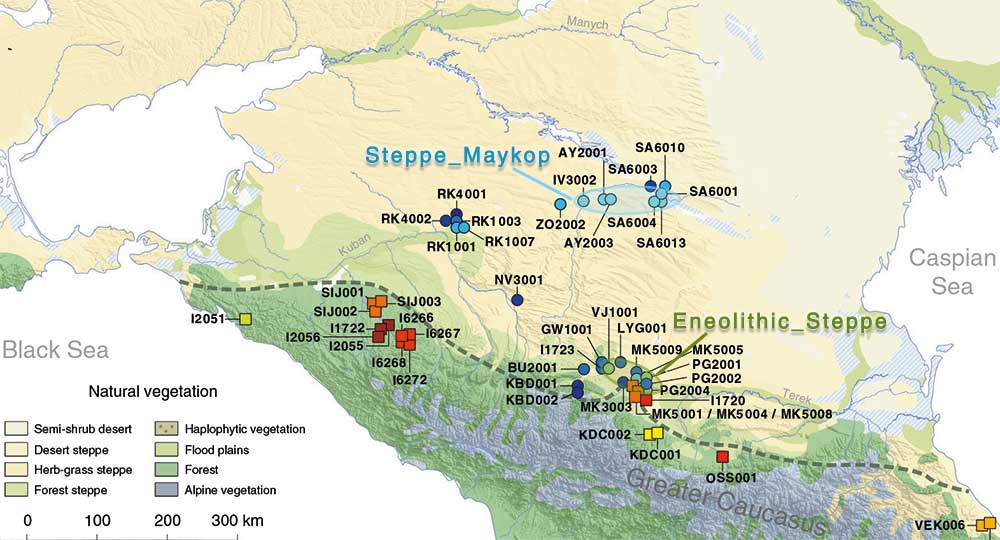
Results are not much different from what has been reported. In general, Yamnaya and related groups such as Bell Beakers and Steppe-related Chalcolithic/Bronze Age populations show good fits for Eneolithic_Steppe as their closest source for Steppe ancestry, and bad fits for Steppe_Maykop, whereas Corded Ware groups show the opposite, supporting their known differences.
This trend seems to be tempered in some groups, though, most likely due the influence of Samara_LN-like admixture in Circum-Baltic Late Neolithic and Eastern Corded Ware groups, and the influence of Anatolia_N/EEF-like admixture in Balkan and late European CWC or BBC groups. In fact, the more EEF-related ancestry in a populatoin, the less reliable these generic models (and even specific ones) seem to become when distinguishing the Steppe-related source.
NOTE. For more on this, see the discussion on Circum-Baltic Corded Ware peoples, and the discussion on Mycenaeans and their potential source populations.
These are just broad strokes of what might have happened around the Pontic–Caspian steppes before and during the Early Bronze Age expansions. The most relevant quest right now for Indo-European studies is to ascertain the chain of admixture events that led to the development and expansion of Indo-Uralic and its offshoots, Indo-European and Uralic.
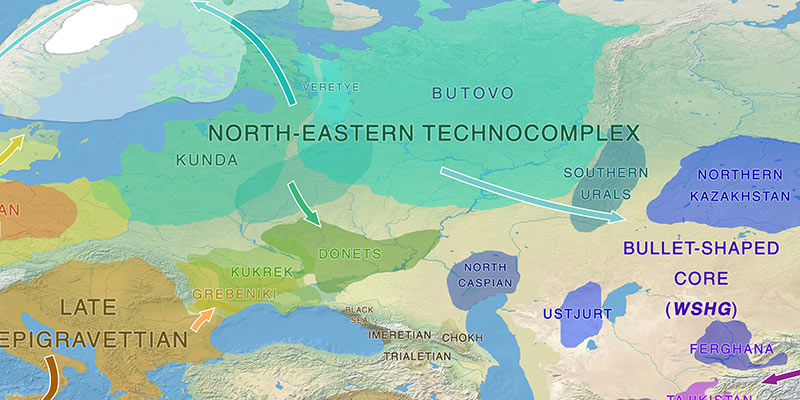
A history of Steppe ancestry
This post is divided in (more or less accurate) chronological developments as follows:
- Hunter-gatherer pottery and the steppes
- Khvalynsk and Sredni Stog
- Post-Stog and Proto-Corded Ware
- Yamnaya and Afanasievo
1. Hunter-gatherer pottery and the steppes
I laid out in the ASOSAH book series the general idea – based on attempts to reconstruct the linguistic ancestor of Indo-Uralic – that Eurasiatic speakers might have expanded with the North-Eastern Techno-Complex that spread through north-eastern Europe during the warm period represented by the transition of the Palaeolithic to the Mesolithic.
If one were to trust the traditional migrationist view, a post-Swiderian population expanded from central-eastern Europe (potentially related originally to Epi-Gravettian peoples, represented by WHG ancestry) into north-eastern Europe, and then further east into the Trans-Urals, to then reappear in eastern Europe as a back-migration represented by the spread of hunter-gatherer pottery.
The marked shift from WHG-like towards EHG-related ancestry from Baltic Mesolithic (ca. 30%) to Combed Ware cultures (ca. 65%-100%) supports this continuous westward expansion, that is possibly best represented in the currently available sampling by the ‘south-eastern’ shift (CHG:ANE-related) of the hunter-gatherer from Lebyazhinka IV (5600 BC) relative to the older one from Sidelkino (9300 BC), both from the Samara region in the Middle Volga:
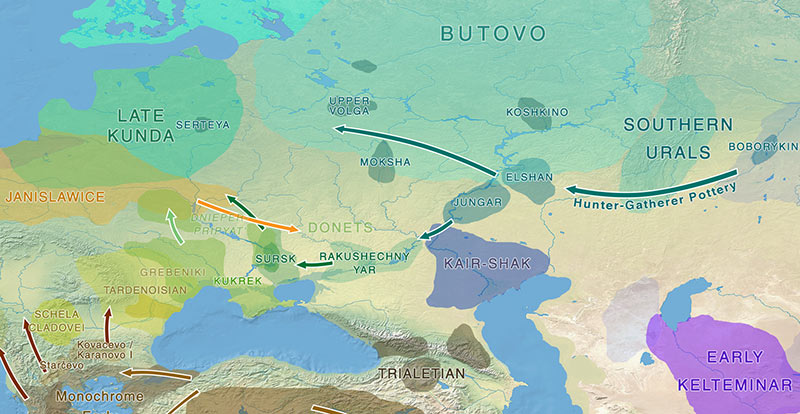
From Anthony (2019):
Along the banks of the lower Volga many excavated hunting-fishing camp sites are dated 6200-4500 BC. They could be the source of CHG ancestry in the steppes. At about 6200 BC, when these camps were first established at Kair-Shak III and Varfolomievka, they hunted primarily saiga antelope around Dzhangar, south of the lower Volga, and almost exclusively onagers in the drier desert-steppes at Kair-Shak, north of the lower Volga. Farther north at the lower/middle Volga ecotone, at sites such as Varfolomievka and Oroshaemoe hunter-fishers who made pottery similar to that at Kair-Shak hunted onagers and saiga antelope in the desert-steppe, horses in the steppe, and aurochs in the riverine forests. Finally, in the Volga steppes north of Saratov and near Samara, hunter-fishers who made a different kind of pottery (Samara type) and hunted wild horses and red deer definitely were EHG. A Samara hunter-gatherer of this era buried at Lebyazhinka IV, dated 5600-5500 BC, was one of the first named examples of the EHG genetic type (Haak et al. 2015). This individual, like others from the same region, had no or very little CHG ancestry. The CHG mating network had not yet reached Samara by 5500 BC.
Given the lack of a proper geographical and chronological transect of ancient DNA from eastern European groups, and the discontinuous appearance of both R1b-M73 and R1b-M269 lineages on both sides of the Urals within the WHG:ANE cline, where EHG appears to have formed, it is impossible at this point to assert anything with enough degree of certainty. For simplicity purposes, though, I risked to equate the expansion of R1b-M73 in West Siberia as potentially associated with Micro-Altaic, and the expansion of hg. R1b-M269 with the spread of Indo-Uralic on both sides of the Urals.
NOTE. For incrementally speculative associations of languages with prehistoric cultures and their potential link to ancestry ± haplogroup expansions, you can check sections on Early Indo-Europeans and Uralians, Indo-Uralians, Altaic peoples, Eurasians, or Nostratians. I explained why I made these simplistic choices here.
While this identification of the Indo-Uralic expansion with hg. R1b is more or less straightforward for the Cis-Urals, given the available ancient DNA samples, it will be very difficult (if at all possible) to trace the migration of these originally R1b-M269-rich populations into Trans-Uralian groups that could eventually be linked to Yukaghir speakers. The sheer number of potential admixture events and bottlenecks in Siberian forest, taiga, and tundra regions since the Mesolithic until Yukaghirs were first attested is guaranteed to give more than one headache in upcoming years…
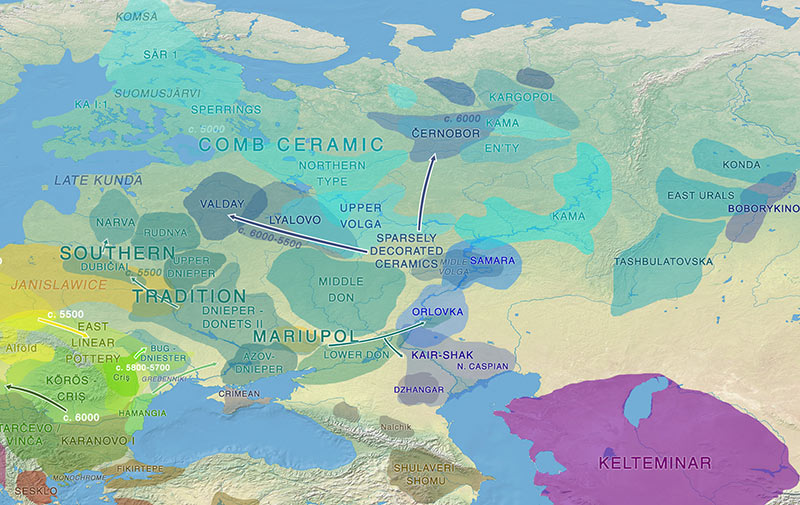
The slight increase in WHG-related ancestry in Ukraine Neolithic groups relative to Mesolithic ones questions the arrival of this eastern influence in the north Pontic area, or at least its relevance in genomic terms, although the cluster formed is similar to the previous one and to Combed Ware groups – despite the Central European and Baltic influences in the north Pontic region – with some samples showing 0% change relative to Mesolithic groups.
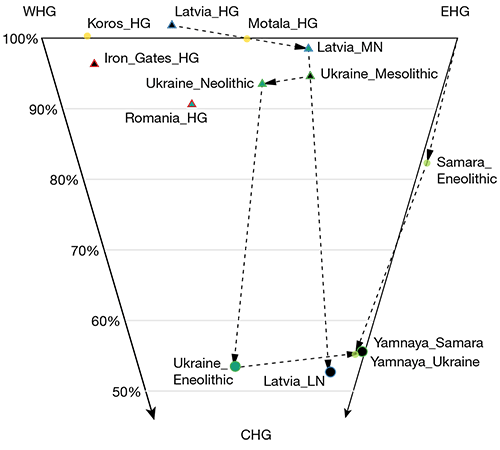
NOTE. For more on Indo-Uralic and its reconstruction from a linguistic point of view, check out its dedicated section on ASOSAH, or the recently published (behind paywall) The Precursors of Proto-Indo-European, edited by Kloekhorst and Pronk, Brill (2019). Authors of specific chapters have posted their contributions to Academia.edu, where they can be downloaded for free.
2. Khvalynsk and Sredni Stog
The cluster formed by the three available samples of the Khvalynsk culture (early 5th millennium BC) might be described, as expected from its position in the PCA, as a mixture of EHG-like populations of the Middle Volga with CHG-like ancestry close to that represented by samples from Progress-2 and Vonyuchka, in the North Caucasus Piedmont (ca. 4300 BC):
This variable CHG-like admixture shown in the wide cluster formed by the available Khvalynsk-related samples support the interpretation of a recently created CHG mating network in Anthony (2019):
After 5000 BC domesticated animals appeared in these same sites in the lower Volga, and in new ones, and in grave sacrifices at Khvalynsk and Ekaterinovka. CHG genes and domesticated animals flowed north up the Volga, and EHG genes flowed south into the North Caucasus steppes, and the two components became admixed. After approximately 4500 BC the Khvalynsk archaeological culture united the lower and middle Volga archaeological sites into one variable archaeological culture that kept domesticated sheep, goats, and cattle (and possibly horses). In my estimation, Khvalynsk might represent the oldest phase of PIE.
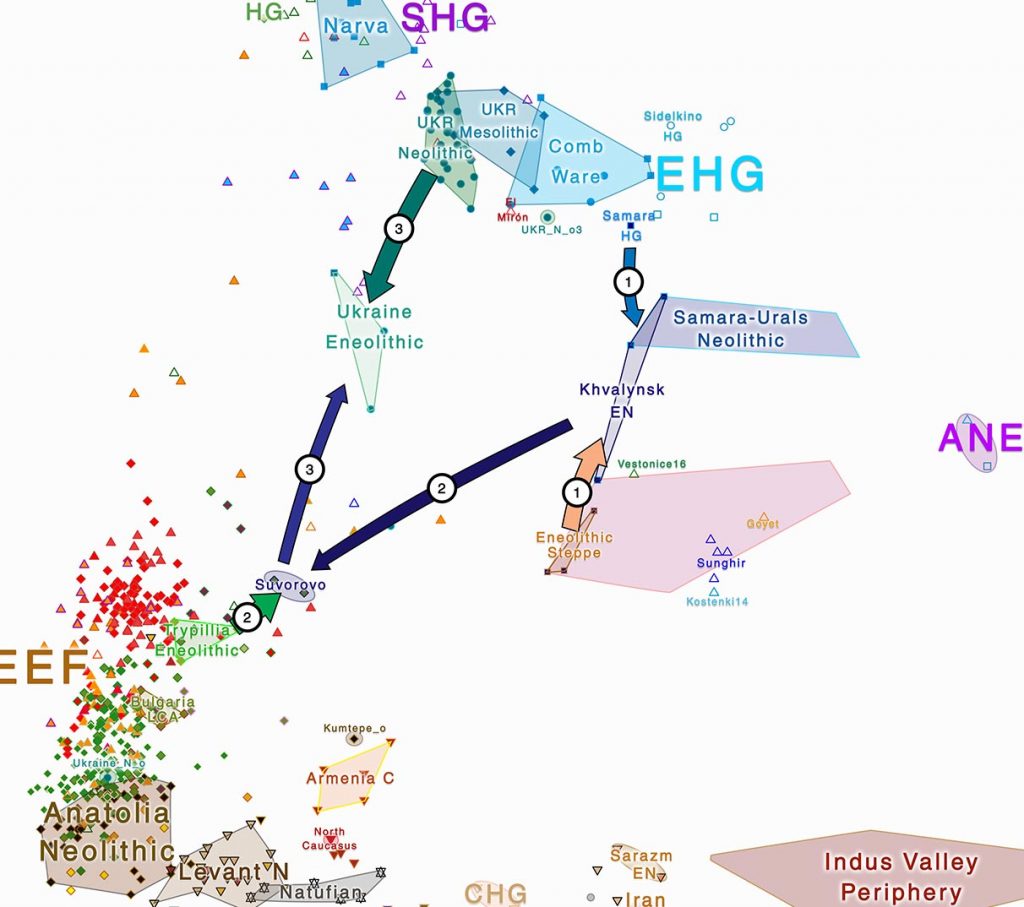
The richest copper assemblage found in all Khvalynsk burials belongs to an individual of hg. R1b-V1636 and intermediate Samara_HG:Eneolithic_Steppe ancestry, while full Eneolithic_Steppe-like admixture in the Middle Volga is represented by the commoner of Khvalynsk II, of hg. Q1. The finding of hg. R1b-V1636 in the North Caucasus Piedmont – and R1b-P297 in the Samara region (probably including Yekaterinovka) begs the question of the origin of hg. R1b-V1636 in the Khvalynsk community. Based on its absence in ancient samples from the forest zone, it is tempting to assign it to steppe hunter-gatherers down the Lower Volga and possibly to the east of it, who infiltrated the Samara region precisely during these population movements described by Anthony (2019).
Suvorovo-related samples from the Balkans, including the Varna and Smyadovo outliers of Steppe ancestry, are closely related to the Khvalynsk expansion:
Similarly, the ancestry of late Sredni Stog samples from Dereivka seem to be directly related to the expansion of Mariupol-like individuals over populations of Suvorovo-Novodanilovka-like admixture, as suggested by the resurgence of typical Ukraine Neolithic haplogroups, the shift in the PCA, and the models of Eneolithic_Steppe vs. Steppe_Maykop above:
#EDIT (11 Nov 2019): In fact, the position of the unpublished Greece_Neolithic outlier that appeared in the Wang et al. (2018) preprint (see full PCA and ADMIXTURE) show that the expanding Suvorovo chiefs from the Balkans formed a tight cluster close to the two published outliers with Steppe ancestry from Bulgaria.
The Ukraine_Neolithic outlier, possibly a Novodanilovka-related sample suggests, based on its position in the PCA close to the late Trypillian outlier of Steppe-related ancestry, that Ukraine_Eneolithic samples from Dereivka are a mixture of Ukraine_Neolithic and a Novodanilovka-like community similar to Suvorovo.
The Trypillian_Eneolithic-like admixture found among Proto-Corded Ware peoples (see below) would then feature potentially a small Steppe_Eneolithic-like component already present in the north Pontic area, too.
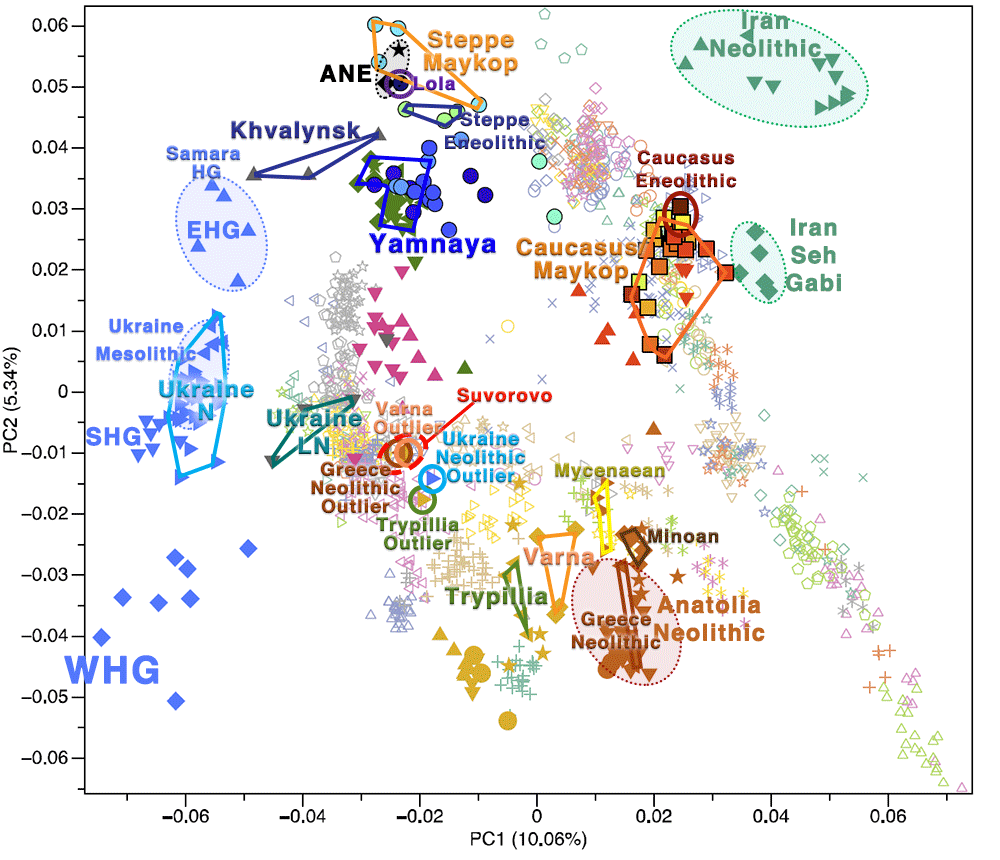
Furthermore, whereas Anthony (2019) mentions a long-lasting predominance of hg. R1b in elite graves of the Eneolithic Volga basin, not a single sample of hg. R1a is mentioned supporting the community formed by the Alexandria individual, supposedly belonging to late Sredni Stog groups, but with a Corded Ware-like genetic profile (suggesting yet again that it is possibly a wrongly dated sample).
NOTE. A lack of first-hand information rather than an absence of R1a-M417 samples in the north Pontic forest-steppes would not be surprising, since Anthony is involved in the archaeology of the Middle Volga, but not in that of the north Pontic area.
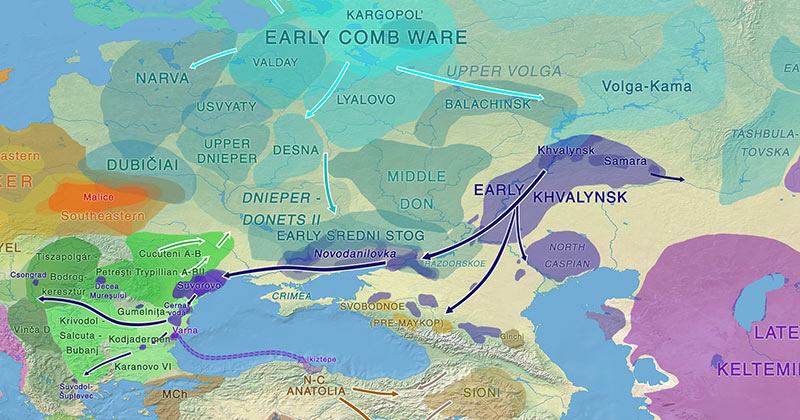
3. Post-Stog and Proto-Corded Ware
The origin of the Pre-Corded Ware ancestry is still a mystery, because of the heterogeneity of the sampled groups to date, and because the only ancestral sample that had a compatible genetic profile – I6561 from Alexandria – shows some details that make its radiocarbon date rather unlikely.
The most likely explanation for the closest source population of Corded Ware groups, found in the three core samples of Steppe_Maykop and in Trypillian Eneolithic samples from the first half of the 4th millennium BC, is still that a population of north Pontic forest-steppe hunter-gatherers hijacked this kind of ancestry, that was foreign to the north Pontic region before the Late Eneolithic period, later expanding east and west through the Podolian–Volhynian upland, due to the complex population movements of the Late Eneolithic.
NOTE. The idea of Trypillia influencing the formation of the Steppe_MLBA ancestry proper of Uralic peoples has been around for quite some time already, since the publication of Narasimhan et al. (2018) (see here or here).
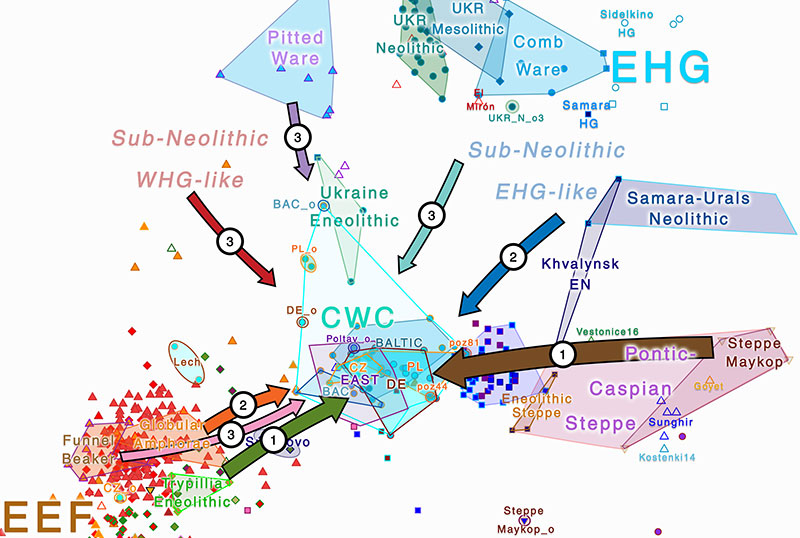
The specifics of how the Proto-Corded Ware community emerged remain unclear at this point, despite the simplistic description by Rassamakin (1999) of the Late Eneolithic north Pontic population movements as a two-stage migration of 1) late Trypillian groups (Usatovo) west → east, and (2) Late Maykop–Novosvobodnaya east → west. So, for example, Manzura (2016) on the Zhivotilovka “cultural-historical horizon” (emphasis mine):
Indeed, the very complex combination of different cultural traits in the burial sites of the Zhivotilovka type is able to generate certain problems in the search for the origins of this phenomenon. The only really consistent attribute is the burial rite in contracted position on the left or right side. Yu. Rassamakin is correct in asserting that this position of the deceased can be considered as new in the North Pontic region (Rassamakin 1999, 97). However, this opinion can be accepted only partially for the territory between Dniester and Lower Don. This position is well known in the Usatovo culture in the Northwest Pontic region, although skeletons on the right side are evidenced there only in double burials, whereas single burials contain the deceased only in a contracted position on the left side. On the other hand, the southern and western orientation of the deceased, which is one of the main burial traits of the Zhivotilovka type, is not characteristic of the Usatovo culture. Nevertheless, it is possible to suppose that at least part of the Usatovo population could have played a part in the formation of the cultural type under consideration here. One aspect of this cultural tradition, for instance, could be represented by skeletons on the left side and oriented in north-eastern and eastern directions.
Especially close ties can be traced between the Zhivotilovka and Maykop-Novosvobodnaya traditions, as exemplified by similar burial customs and various grave goods. It is beyond any doubt that the Maykop-Novosvobodnaya population was actively involved in the spread of the main Zhivotilovka cultural traits. The influence of North Caucasian traditions can be well observed, at least as far as the Dnieper Basin, but farther west influence is not manifested pronouncedly. The role of cultural units situated between the Dniester and Don rivers in the process of emergence of the Zhivotilovka type looks somewhat vague. Now, it can be quite confidently asserted that at the end of the 4th millennium BC this territory was settled by migrants from the North Caucasus and Carpathian-Dniester region. This event in theory had to stimulate cultural transformations in the Azov-Black Sea steppes and, thus, bearers of local cultural traditions perhaps could have participated in forming the culture under consideration. In any event, the Zhivotilovka type can be regarded as a complex phenomenon that emerged within the regime of intensive cultural dialogue and that it absorbed totally diff erent cultural traditions. The spread of the Zhivotilovka graves across the Pontic steppes from the Carpathians to the Lower Don or even to the Kuban Basin clearly signalizes a rapid dissolution of former cultural borders and the beginning of active movements of people, things and ideas over vast territories.
What were the factors or reasons that could have provoked this event? In the beginning of the second half of the 4th millennium BC two advanced cultural centers emerged in the south of Eastern Europe. These were the Maykop-Novosvobodnaya and Usatovo cultures, which in spite of their separation by great distances were structurally very alike. This is expressed in similar monumental burial architecture, complex burial rites, even the composition of grave goods, developed bronze metallurgy, high standards of material culture, etc. Both cultures in a completely formed state exemplify prosperous societies with a high level of economic and social organization, which can correspond to the type of ranked or early complex societies. Normally, the social elite in such polities tends to rigidly control basic domains social, economic and spiritual life using different mechanisms, even open compulsion (Earle 1987, 294-297). To some extent similar social entities can be found at this moment in the forest-steppe zone of the Carpathian-Dniester region, as reflected by the well organized settlement of Brânzeni III and the Vykhatitsy cemetery (Маркевич 1981; Дергачев 1978). In spite of their complex character, such societies represent rather friable structures, which could rapidly disintegrate due to unfavourable inner or external factors.
The societies in question emerged and existed during a time of favourable natural climatic conditions, which is considered to be a transitional period from the Atlantic to the Subboreal period, lasting approximately from 3600 to 3300 cal BC, or a climatic optimum for the steppe zone (Иванова и др. 2011, 108; Спиридонова, Алешинская 1999, 30-31). These conditions to a large degree could guarantee a stable exploitation of basic resources and support existing social hierarchies. However, after 3300 cal BC significant climatic changes occurred, accompanied by an increasing aridization and fall in temperature. This event is usually termed the “Piora oscillation” or “Rapid Climatic Event”, and is regarded as having been of global character (Magny, Haas 2004). These rapid changes could have seriously disturbed existing economic and social relations and finally provoked a similar rapid disintegration of complex social structures. In this case the sites of the Zhivotilovka type could represent mere fragments of former prosperous societies, which under conditions of the absence of centralized social control and stable cultural borders tried to recombine social and economic ties. However, the population possessed the necessary social experience and important technological resources, such as developed stock-breeding based on the breeding of small cattle and wheeled transport, so they were ready for opening new territories in their search for a better life.
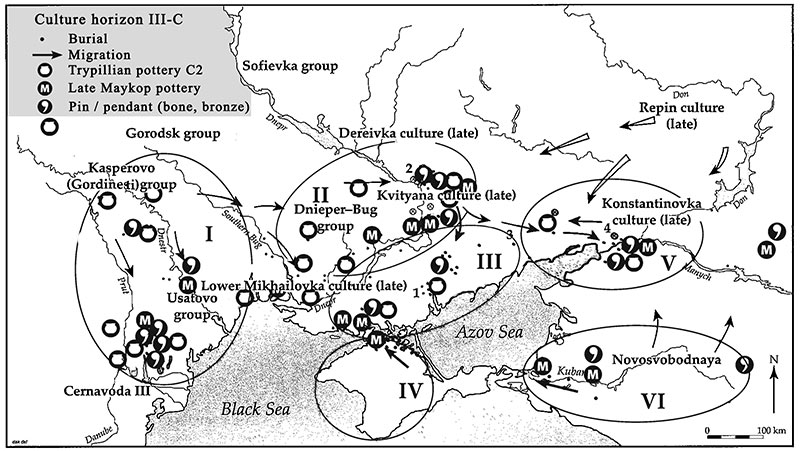
For more on chronology and the potentially larger, longer-lasting Zhivotilovka–Volchansk–Gordineşti cultural horizon and its expansion through the Podolian–Volhynian upland, read e.g. on the Yampil Complex in the latest volume 22 of Baltic-Pontic Studies (2017):
In the forest-steppe zone of the North-West Pontic area, important data concerning the chronological position of the Zhivotilovka-Volchansk group have been produced by the exploration of the Bursuceni kurgan, which is still awaiting full publication [Yarovoy 1978; cf. also Demcenko 2016; Manzura 2016]. Burials linked with the mentioned group were stratigraphically the eldest in the kurgan, and pre-dated a burial in the extended position and [Yamnaya culture] graves. Two of these burials (features 20 and 21) produced radiocarbon dates falling around 3350-3100 BC [Petrenko, Kovaliukh 2003: 108, Tab. 7]. Similar absolute age determinations were obtained for Podolia kurgans at Prydnistryanske [Goslar et al. 2015]. These dates, falling within the Late Eneolithic, mark the currently oldest horizon of kurgan burials in the forest-steppe zone of the North-West Pontic area. The Podolia graves linked with other, older traditions of the steppe Eneolithic seem to represent a slightly later horizon dated to the transition between the Late Eneolithic and Early Bronze Age.
The presence on the left bank of the Dniester River of kurgans associated with the Eneolithic tradition, which at the same time reveals connections with the Gordineşti-Kasperovce-Horodiştea complex, raises questions about the western range of the new trend in funerary rituals, and its potential connection with the expansion of the late Trypilia culture to the West Podolia and West Volhynia Regions. The data potentially suggesting the attribution of kurgans from the upper Dniester basin to this period is patchy and difficult to verify [e.g. Liczkowce – see Sulimirski 1968: 173]. In this context, the discovery of vessels in the Gordineşti style in a kurgan at Zawisznia near Sokal is inspiring [Antoniewicz 1925].
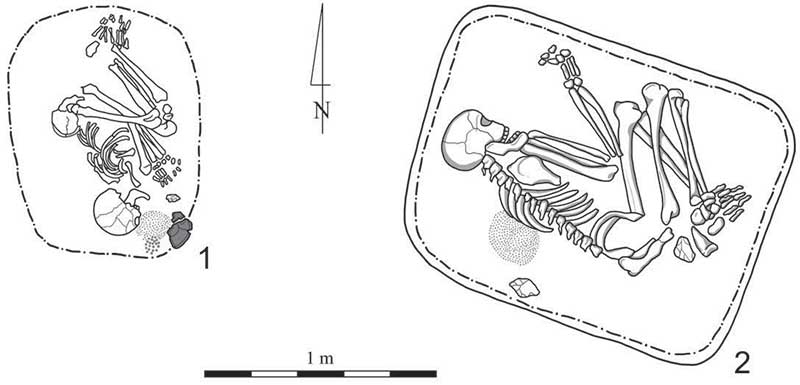
Another interesting aspect of potential source populations, in combination with those above for Eneolithic_Steppe vs. Steppe_Maykop, are groups with worse fits for Steppe_Maykop_core, which include Potapovka and Srubnaya, as reported by Wang et al. (2018), but also Sintastha_MLBA (although not Andronovo). This is compatible with the long-term admixture of Abashevo chiefs dominating over a majority of Poltavka-like herders in the Don-Volga-Ural steppes during the formation of the Sintashta-Potapovka-Filatovka community, also visible in the typical Yamnaya lineages and Yamnaya-like ancestry still appearing in the region centuries after the change in power structures had occurred.
NOTE. If you feel tempted to test for mixtures of Khvalynsk_EN, Eneolithic_Steppe, Yamnaya, etc. as a source population for Corded Ware, go for it, but it’s almost certain to give similar ‘good’ fits – whatever the model – in some Corded Ware groups and not in others. It is still unclear, as far as I know, how to formally distinguish a mixture of Corded Ware-related from a Yamnaya-related source in the same model, and the results obtained with a combination of Steppe_Maykop-related + Eneolithic_Steppe-related sources will probably artificially select either one or the other source, as it probably happened in Ning et al. (2019) with Proto-Tocharian samples (see qpAdm values) that most likely had a contribution of both, based on their known intense interactions in the Tarim Basin.
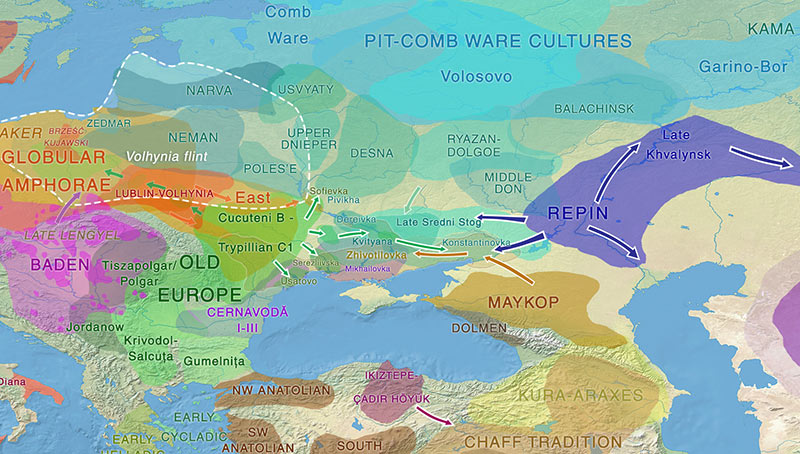
#EDIT (22 NOV 2019): New preprint Gene-flow from steppe individuals into Cucuteni-Trypillia associated populations indicates long-standing contacts and gradual admixture, by Immel et al. bioRxiv (2019), on Gordinești samples from Moldova ca. 3500-3100 BC. Relevant excerpts (emphasis mine):
A principal component analysis of the four Moldova females together with previously published data sets of ancient Eurasians showed that Gordinești, Pocrovca 1 and Pocrovca 3 grouped with later dating Bell Beakers from Germany and Hungary close to the four CTC males from Verteba, while Pocrovca 2 fell into the LBK cluster next to Neolithic farmers from Anatolia and Starčevo individual.
When looking at various proxies for steppe-related ancestry (Yamnaya Samara, Ukraine Mesolithic, Caucasian hunter-gatherer (CHG), Eastern hunter gatherer (EHG)), we did not observe any significant difference in genetic influx from either Yamnaya Samara, EHG or Ukraine Mesolithic. However, relative to CHG, we detected a substantial shift towards Yamnaya Samara steppe-related ancestry. Consequently, Yamnaya Samara, Ukraine Mesolithic and EHG appear to be equally suitable proxies for steppe-related ancestry in the Moldovan CTC individuals.
We did not obtain feasible models when running qpAdm on the X-chromosome in order to test for male-biased admixture from hunter-gatherers or individuals with steppe-related ancestry.
It is not surprising that Gordinești, Pocrovca 1 and Pocrovca 3 showed genetic affinities with later dating Bronze Age or Bell Beaker individuals. The common link among them is the considerable steppe-related ancestry, which each group likely received independently from different parental populations.
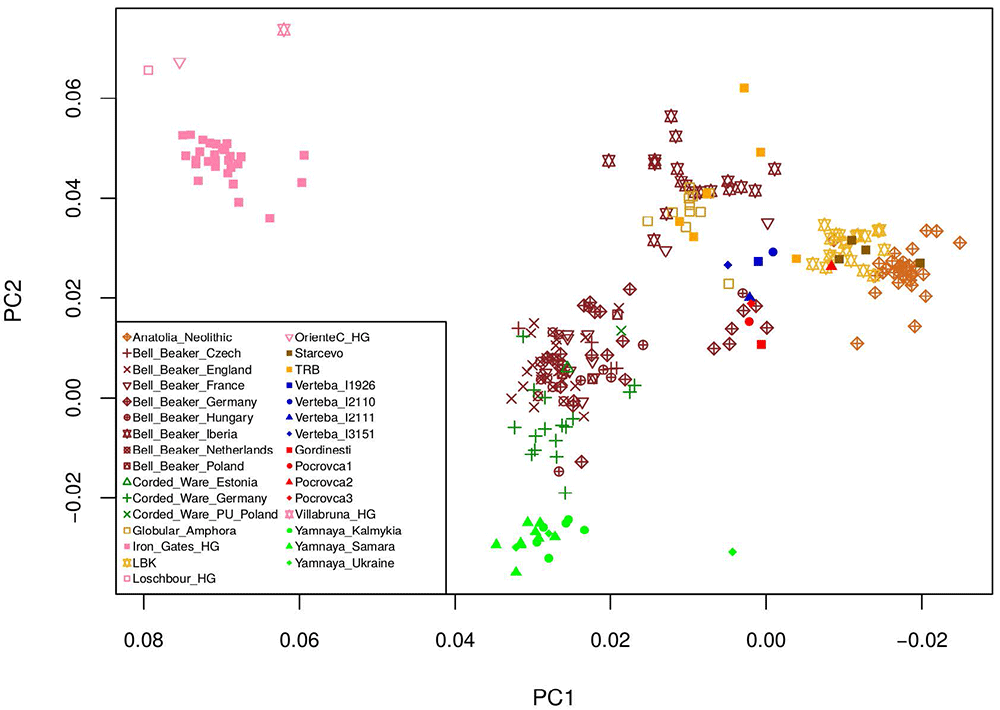
4. Yamnaya and Afanasievo
I don’t think it makes much sense to test for GAC (or Iberia_CA, for that matter) as Wang et al. (2019) did, given the implausibility of them taking part in the formation of late Repin during the mid-4th millennium BC around the Don-Volga interfluve (represented by its offshoots Yamnaya and Afanasievo), whether these or other EEF-related populations show ‘better’ fits or not. Therefore, I only tested for more or less straightforward potential source populations:
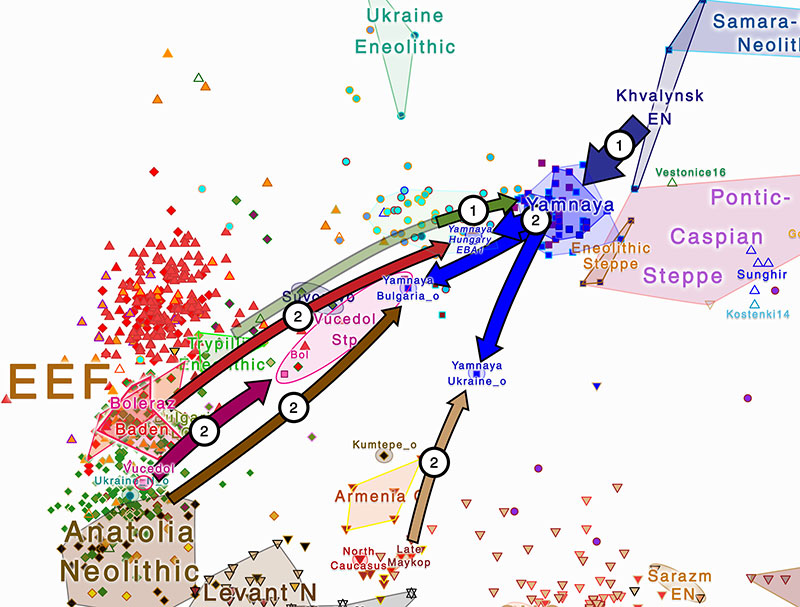
Quite unexpectedly – for me, at least – it appears that Afanasievo and Yamnaya invariably prefer Khvalynsk_EN as the closest source rather than a combination including Eneolithic_Steppe directly. In other words, late Repin shows largely genetic continuity with the Steppe ancestry already shown by the three sampled individuals from the Khvalynsk II cemetery, in line with the known strong bottlenecks of Khvalynsk-related groups under R1b lineages, visible also later in Afanasievo and Yamnaya and derived Indo-European-speaking groups under R1b-L23 subclades.
NOTE. This explains better the reported bad fits of models using directly Eneolithic_Steppe instead of Khvalynsk_EN for Afanasievo and Yamnaya Kalmykia, as is readily evident from the results above, instead of a rejection of an additional contribution to an Eneolithic_Steppe-like population, as I interpreted it, based on Anthony (2019).
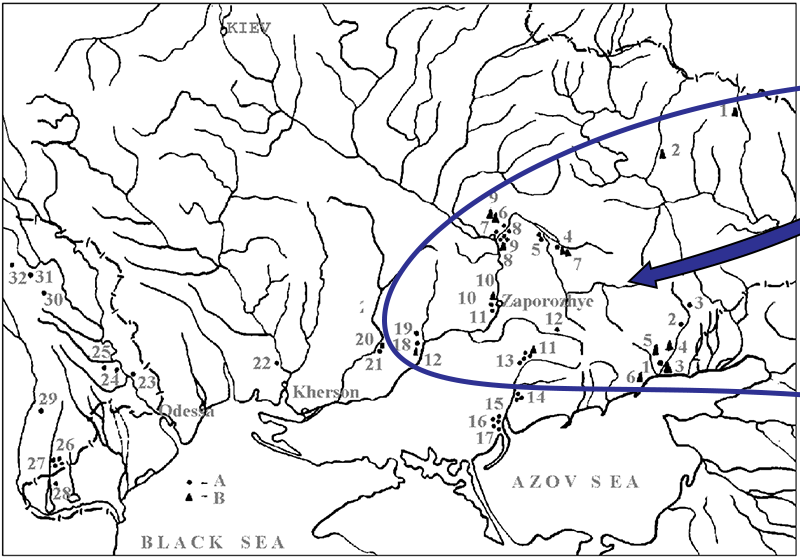
This might suggest that the Steppe ancestry visible in samples from Progress-2 and Vonyuchka, sharing the same cluster with the Khvalynsk II cemetery commoner of hg. Q1, most likely represents North Caspian or Black Sea–Caspian steppe hunter-gatherer ancestry that increased as Khvalynsk settlers expanded to the south-west towards the Greater Caucasus, probably through female exogamy. That would mean that Steppe_Maykop potentially represents the ‘original’ ancestry of steppe hunter-gatherers of the North Caucasus steppes, which is also weakly supported by the available similar admixture of the Lola culture. The chronology, geographical location and admixture of both clusters seemed to indicate the opposite.

Due to the limitations of the currently available sampling and statistical tools, and barring the dubious Alexandria outlier, it is unclear how much of the late Trypillian-related admixture of late Repin (as reflected in Yamnaya and Afanasievo) corresponds to late Trypillian, Post-Stog, or Proto-Corded Ware groups from the north Pontic area. A mutual exchange suggestive of a common mating network (also supported by the mixed results obtained when including Khvalynsk_EN as source for early Corded Ware groups) seem to be the strongest proof to date of the Late Proto-Indo-European – Uralic contacts reflected in the period when post-laryngeal vocabulary was borrowed (with some samples predating the merged laryngeal loss), before the period of intense borrowing from Pre- and Proto-Indo-Iranian.
Between-group differences of Yamnaya samples are caused – like those between Corded Ware groups – by the admixture of a rapidly expanding society through exogamy with regional populations, evidenced by the inconstant affinities of western or southern outliers for previous local populations of the west Pontic or Caucasus area. This explanation for the gradual increase in local admixture is also supported by the strong, long-term patrilineal system and female exogamy practiced among expanding Proto-Indo-Europeans.
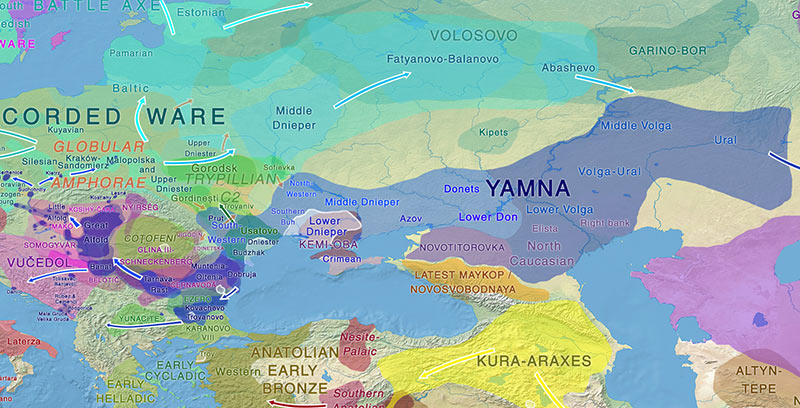
Bell Beakers and Mycenaeans
This Eneolithic_Steppe ancestry is also found among Bell Beaker groups (see above). More specifically, all Bell Beaker groups prefer a source closest to a combination of Yamnaya from the Don and Baden LCA individuals from Hungary, rather than with Corded Ware and GAC, despite the quite likely admixture of western Yamnaya settlers with (1) south-eastern European (west Pontic, Balkan) Chalcolithic populations during their expansion through the Lower Danube and with (2) late Corded Ware groups (already admixed with GAC-like populations) during their expansion as East Bell Beakers:
Similarly, Mycenaeans show good fits for a source close to the Yamnaya outlier from Bulgaria:
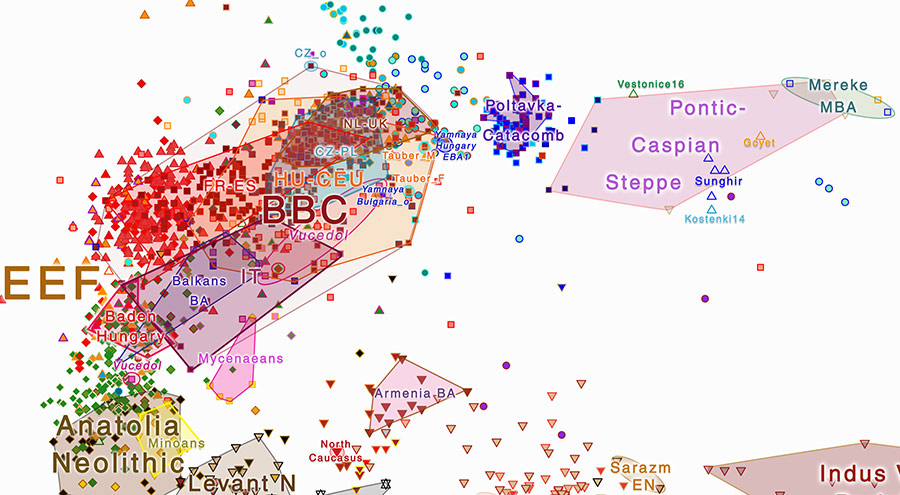
You can read more on Yamnaya-related admixture of Bell Beakers and Mycenaeans, and on Afanasievo-related admixture of Iron Age Proto-Tocharians.
Conclusion
The use of the concept of “Yamnaya ancestry”, then “Steppe ancestry” (and now even “Yamnaya Steppe ancestry“?) has already permeated the ongoing research of all labs working with human population genomics. Somehow, the conventional use of Yamnaya_Samara samples opposed to a combination of other ancient samples – alternatively selected among WHG, EHG, CHG/Iran_N, Anatolia_N, or ANE – has spread and is now unquestionably accepted as one of the “three quite distinct” ancestral groups that admixed to form the ancestry of modern Europeans, which is a rather odd, simplistic and anachronistic description of prehistory…
It has now become evident that authors involved with the Proto-Indo-European homeland question – and the tightly intertwined one of the Proto-Uralic homeland – are going to dedicate a great part of the discussion of many future papers to correct or outright reject the conclusions of previous publications, instead of simply going forward with new data.
The most striking argument to mistrust the current use of “Steppe ancestry” (as an alternative name for Yamnaya_Samara, and not as ancestry proper of steppe hunter-gatherers) is not the apparent difference in direct Eneolithic sources of Steppe ancestry for Corded Ware and Yamnaya-related peoples – closer to the available samples classified as Steppe_Maykop and Eneolithic_Steppe, respectively – or their different evolution under marked Y-DNA bottlenecks.
It is not even the lack of information about the distant origin of these Pontic–Caspian steppe hunter-gatherers of the 5th and 4th millennium BC, with their shared ancestral component potentially separated during the warmer Palaeolithic-Mesolithic transition, when the steppes were settled, without necessarily sharing any meaningful recent history before the formation of the Proto-Indo-Uralic community.
NOTE. I have raised this question multiple times since 2017 (see e.g. here or here).
The most striking paradox about simplistically misinterpreting “Steppe ancestry” as representative of Indo-European expansions is that those sub-Neolithic Pontic–Caspian steppe hunter-gatherers that had this ancestry in the 6th millennium BC were probably non-Indo-European-speaking communities, most likely related to the North(West) Caucasian language family, based on the substrate of Indo-Anatolian that sets it apart from Uralic within the Indo-Uralic trunk, and on later contacts of Indo-Tocharian with North-West Caucasian and Kartvelian, the former probably represented by Maykop and its contact with the Repin and early Yamnaya cultures.
NOTE. For more on this, see Allan Bomhard’s recent paper on the Caucasian substrate hypothesis and its ongoing supplement Additional Proto-Indo-European/Northwest Caucasian Lexical Parallels.
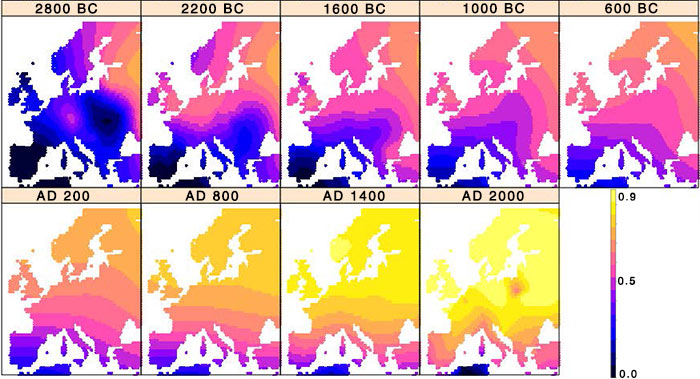
This kind of error happens because we all – hence also authors, peer reviewers, and especially journal editors – love far-fetched conclusions and sensational titles, forgetting what a paper actually shows and – always more importantly in scientific reports – what it doesn’t show. This is particularly true when more than one field is involved and when extraordinary claims involve aspects foreign to the journal’s (and usually the own authors’) main interests. One would have thought that the glottochronological fiasco published in Science in 2012 (open access in PMC) should have taught an important lesson to everyone involved. It didn’t, because apparently no one has felt the responsibility or the shame to retract that paper yet, even in the age of population genomics.
If anything, the excesses of mathematical linguistics – using computational methods to try and reconstruct phylogenetic trees – have perpetuated a form of misunderstood Scientism which blindly relies on a simple promise made by authors in the Materials and Method section (rarely if ever kept beyond it) to use statistics rather than resorting to the harder, well-informed, comprehensive reasoning that is needed in the comparative method. After all, why should anyone invest hundreds of hours (or simply show an interest in) learning about historical linguistics, about ancient Indo-European or Uralic languages, carefully argumenting and discussing each and every detail of the reconstruction, when one can simply rely on the own guts to decide what is Science and what isn’t? When one can trust a promise that formulas have been used?
101 BS THINGS TAUGHT TO STUDENTS, 15
That Indo European languages were born in the Eurasian Pontic-Caspian steppes/Northern Caucasus.
Much higher possibility they were born in East-Med, Anatolia. pic.twitter.com/avls6ZtvNS— Nassim Nicholas Taleb (@nntaleb) September 2, 2019
The conservative, null hypothesis when studying prehistoric Eurasian samples related to evolving cultures was universally understood as no migration, or “pots not people” (as most western archaeologists chose to believe until recently), whereas the alternative one should have been that there were in fact migration events, some of them potentially related to the expansion of Eurasian languages ancestral to the historically attested ones. Beyond this migrationist view there were obviously dozens of thorough theories concerning potential linguistic expansions associated with specific prehistoric cultures, and a myriad of less developed alternatives, all of which deserved to be evaluated after the null hypothesis had been rejected.
Despite the shortcomings of the 2015 papers and their lack of testing or discussion of different language expansion models, the spread of the so-called “Yamnaya ancestry” – an admixture especially prevalent (after the demise of the Yamnaya) among the most likely ancient Uralic-speaking groups as well as among modern Uralic speakers and recently acculturated groups from Eastern Europe – has been nevertheless invariably concluded by each lab to support the theories of their leading archaeologist, often combined with pre-aDNA theories of geneticists based on modern haplogroup distributions. This is as evident a case of confirmation bias, circular reasoning, and jumping to conclusions as it gets.
Why many researchers of other labs have chosen to follow such conclusions instead of challenging or simply ignoring them is difficult to understand.
Related
- Bell Beakers and Mycenaeans from Yamnaya; Corded Ware from the forest steppe
- On the Ukraine Eneolithic outlier I6561 from Alexandria
- Yamnaya replaced Europeans, but admixed heavily as they spread to Asia
- East Bell Beakers, an in situ admixture of Yamna settlers and GAC-like groups in Hungary
- Trypillia and Greece Neolithic outliers: the smoking gun of Proto-Anatolian migrations?
- Corded Ware culture origins: The Final Frontier
- Volga Basin R1b-rich Proto-Indo-Europeans of (Pre-)Yamnaya ancestry
- Yamnaya ancestry: mapping the Proto-Indo-European expansions
- The genetic and cultural barrier of the Pontic-Caspian steppe – forest-steppe ecotone
- On the origin of haplogroup R1b-L51 in late Repin / early Yamna settlers
- On the origin and spread of haplogroup R1a-Z645 from eastern Europe
- North Pontic steppe Eneolithic cultures, and an alternative Indo-Slavonic model
